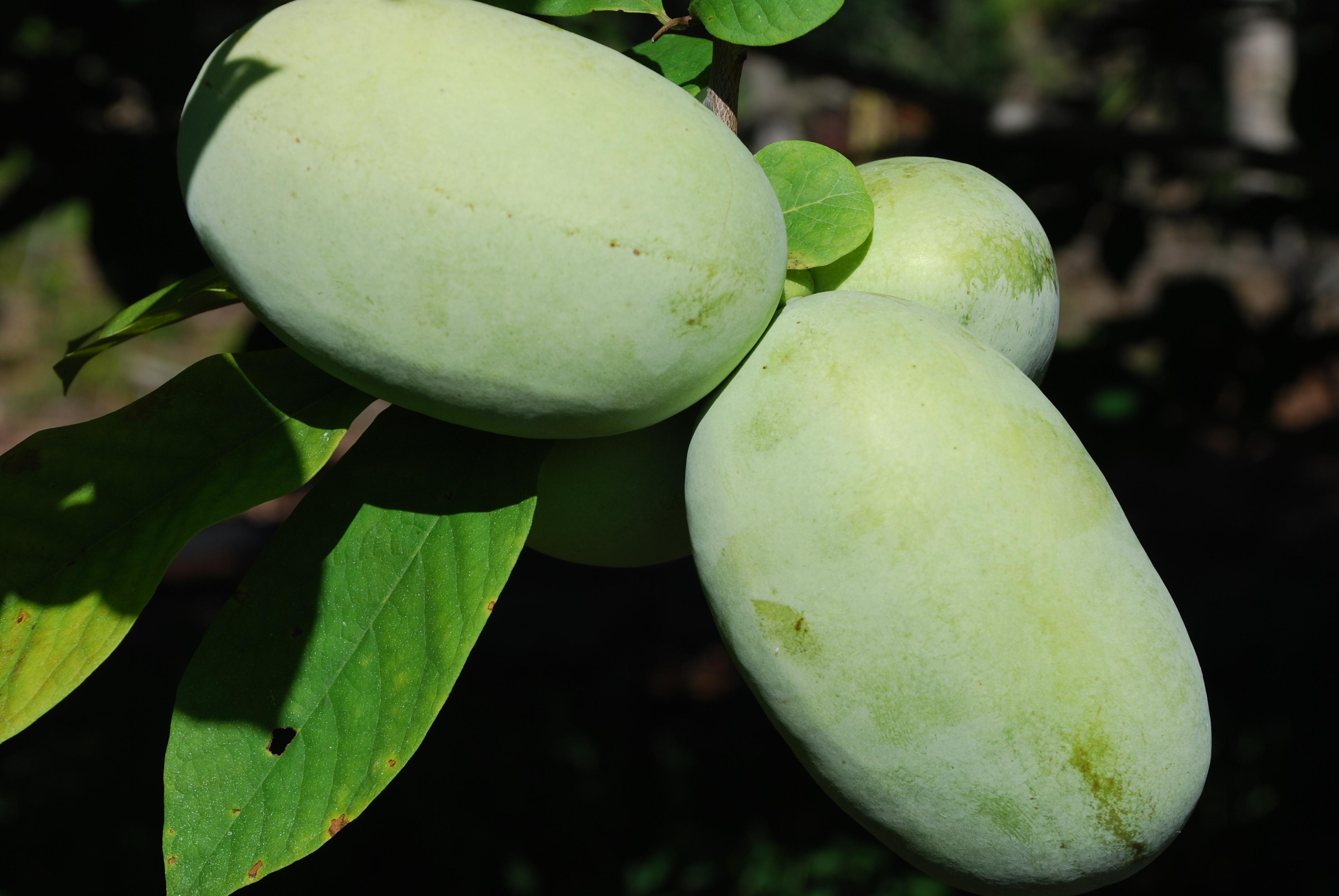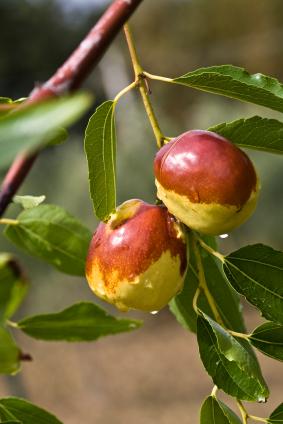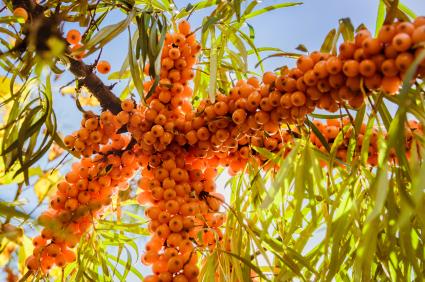
“Fine fruit is the flower of commodities. It is the most perfect union of the useful and the beautiful that the earth knows. Trees full of soft foliage; blossoms fresh with spring bounty; and, finally, fruit, rich, bloom-dusted, melting, and luscious—such are the treasures of the orchard and garden, temptingly offered to every landholder in this bright and sunny, though temperate climate.”
– Andrew Jackson Downing
Uncommonly delicious, uncommonly beautiful, uncommonly easy to grow … Yes, yes, yes. There is a world of fruit trees and bushes beyond the peach, cherry, and blueberry. These uncommon fruits fit perfectly in the front or backyard and require very little of you other than picking abundant harvests.
Culturally we have become accustomed to a handful of fruit trees and bushes that require an orchardist’s hand and arsenal of sprays. But it’s time for a revolution in the backyard. A revolution that brings us more ease in cultivation and rewards us with naturally healthy trees that drip with uncommon but delectable tastes.
The following fruits are just a sampling of the cornucopia that awaits to root in your landscape, titillate the senses, and fill the fruit bowl. Chosen for ease of care, beauty and taste. Recommended reading on these and many other easy to grow fruits is found in chapter 5 of ‘Edible Landscaping with a Permaculture Twist.’
Zones
The United States Department of Agriculture (USDA) has created a map that outlines 11 zones across the country to mark the lowest average temperature in each region. Although approximate, it helps the gardener choose plants hardy to their region. The most up-to-date hardiness map can be found at the National Arbor Day Foundation website: http://www.arborday.org/media/zones.cfm.
 Paw Paw
Paw Paw
Asimina triloba
Zones: 5-9
Pollination: Needs cross pollination with another variety
Imagine a carefree, ornamental tree with a fruit filled with the creamy custard flavors of banana, mango, pineapple, and hints of vanilla. Meet the Paw Paw. Reputed to be the largest ‘native’ fruit grown in North America, it is little-known to most Americans. The Paw Paw does not have a long storage life, nor does it have a thick skin needed for transporting. Otherwise, this exquisite fruit would be a well-known and favored fruit on the shelf. Ornamentally the Paw Paw stands alone with a perfect pyramid-shape and long tropical-looking leaves that remain lush all summer long before giving a spectacular show of golden fall color. Paw Paw’s grow up to 25 feet tall but are easily maintained at 8 to 15 feet in height.
Though the Paw Paw grows wild as an understory plant, they fruit best in full sun. They make beautiful care-free front yard specimens with their pyramid shape, lush leaves, and brilliant golden fall foliage. Mulch well to keep soil cool and moist, much like the forest floor, and to help catch dropping fruit which bruises easily.
The fruit can range from 3 – 6 inches long by 1 – 3 inches wide, about the size of a mango. The skin is smooth, green, and fragrant, and the flesh is creamy white to golden yellow with two rows of dark flat seeds. Once ripe, Paw Paws only last for a few days – maybe a week in the fridge – so eat your fill and freeze the rest for making ice cream and smoothies. A good harvest can bring in a bushel per tree, about 40 – 50lbs.
Note: plant grafted varieties or select seedling grown in deep pots. The grafting will ensure consistency of growth and output, such as size, flavor, vigor, ripening time, and good yields, while the deep pots make sure the long tap root is not disturbed. Paw Paws planted by seed, called seedlings, do not promise to reproduce their parents’
character.
 Persimmon, Asian & American
Persimmon, Asian & American
Diospyros kaki and Diospyros viginiana
Zones: 6-10 for Asian, 4-10 for American
Pollination: Variable, some need cross-pollination, some are self-fertile
Like the Paw Paw tree, the Asian persimmon has a lush, tropical look, with large, drooping, flawless, green leaves that turn to gold and scarlet in the fall, leaving bright red and orange fruit hanging in the tree like ornaments. The Asian persimmon tree is a prime ornamental specimen that tops out at 15 feet tall. It requires very little care to stay beautiful and productive, even in the late, hot summers. The American persimmon is a stately, tall tree, with fascinating alligator bark. It is widely adaptable and cold-tolerant.
Persimmons are very easy, carefree trees to grow. They are bothered by few pests and affected by few diseases. They grow well in most soil types. For good fruiting, they need to receive full sun for most of the day. Buy young plants, either in deep pots or bare root, that have full undamaged roots. The Asian persimmon grows well in zones 7-10, where max cold temps bottom out at 0°F. Certain varieties, such as Jiro and Saijo, are successfully being grown and harvested in zone 6, where temps typically go no lower than -5°F. The varieties grown in the more northern zones tend to be astringent types, so the fruit from these varieties should be fully ripened before being enjoyed. The American persimmon is tough down to -25ºF, zones 4 – 10.
 Hardy Kiwi
Hardy Kiwi
Actinidia arguta
Zones: 4-9
Pollination: Needs cross-pollination from male plant
The hardy kiwi vine, a cousin of the fuzzy version, grows well in northern climates and is smooth and sweet, rather than hairy and tart. The hardy kiwi fruit is not that well-known commercially because of its short shelf life and wrinkled look when ripened. However, it is a fantastically flavored and productive fruit for the home grower.
Though emerald green on the inside like the fuzzy kiwi fruit, the hardy kiwi fruit looks quite different and produces smaller, inch-long, smooth-skinned fruits that grow in clusters and can be popped whole into the mouth like grapes. It is also a treat on the ornamental side with gorgeous shiny green leaves with red stems that stay lush throughout summer.
To begin, determine if you have an adequate growing area that is able to support the hardy kiwi’s vigorous growth and weight, approximately 200 square feet per plant. Then be sure you are selecting a male and a female plant, or at least one male per eight female plants (all plants sold in stores should be marked either male or female). The variety called “Issai” is an exception and is self-fertile, meaning it can be planted alone, but adding a male will still increase fruit size and yield.
As with grapes, the hardy kiwi vine makes a fruitful cover for a sturdy pergola or arbor. A minimum requirement is for trellising to be at least 6 feet off the ground, with room to spread laterally. This done in a variety of ways: a single wire between well-anchored posts, up a sturdy wall, as T-shaped trellises with multiple wires (like as a clothes line), or top-sturdy woody arbors. Even on top of a carport—the key being to have strength, height, and space.
Jujube 
Ziziphus jujuba
Zones: 6-9
Pollination: Partially self-fertile, best production with 2 varieties
The Chinese Date
How about a small, attractive tree that has no disease or insect problems, doesn’t suffer loss from late frosts, is at its peak of beauty in the heat of summer, and has a fruit as delectable as the apple and date together? Enter the Jujube tree, as carefree an ornamental edible you will meet.
The Jujube is a small elegant tree that grows up to 25 feet tall, boasting immaculate green shiny leaves on pendulous branches that turn golden yellow in the fall, and attractive gray bark for year round beauty. But don’t let their luscious looks fool you, as the Jujube tree will thrive under the harshest conditions.
The Jujube is a sure-fire recommendation for the low maintenance landscape with poor, compacted soil – which I think describes most of suburbia. This is a tree you can stick in the lawn and forget about the care notes. Plant a Jujube and you will be rewarded with a healthy, beautiful specimen that droops with sweet shiny fruit.
The fruit is the size of an apricot with a smooth skin that changes from light green to a handsome mahogany red as it ripens. Just as the fruit turns mahogany it has a delightfully crisp, juicy flesh that is sweet like apples with hints of caramel and almond. Left to ripen longer on the tree, the fruit starts to wrinkle and concentrate its sugars and richness of flavors, earning its name as the Chinese Date.
 Sea Berry
Sea Berry
Hippophae rhamnoides
Zones 3-7
Pollination: Fruit bearing females need cross pollination with male
The Medicinal Wonder
Also known as Sea Buckthorn, this compact regal shrub is widely grown and revered in Europe and Russia as one of the most medicinal fruits on the planet. Beyond its healthful fruits, it is a stand-out beauty in the landscape, growing upright to about 10 feet tall with gorgeous fruit laden branches and narrow silver shimmering leaves.
Like the Goumi, it is widely adaptable to poor soil conditions and fixes its own nitrogen. Unlike the Goumi, you do not want to eat its berries out of hand, unless you really like sour. It’s good to sweeten them up as a juice. Although sour, the Sea Berry is wonderfully flavored, reminiscent of oranges and passion fruit. Small oval fruits are born in late summer and fall as long cascading clusters of bright orange-yellow berries that create a striking contrast to the shrub’s silvery green leaves. A stunning feature in the edible landscape.
The Sea Berry has been used for thousands of years in Eastern Asia and Russia as a cure-all, treating all sorts of health issues and illnesses. A super fruit with an impressive nutritional profile, Sea Berry boasts 14 essential vitamins, super charged anti-oxidants, anti-inflammatory properties, omega’s 3, 6, 7, and 9, and hundreds of other nutrients. The berries’ oil is a healer for any kind of skin damage and is renowned for supporting mucous and tissue membranes. It is beginning to pop up in high end organic skin products like Weleda as a ‘beauty berry’ that nourishes skin and body tissue, from the inside-out. Your all-in-one fruit supplement!
In the Landscape
The Sea Berry is adapted just about everywhere in its regional range, even in sand. It’s perfect for that ignored part of the landscape that has poor dry soils, high or low pH, and where nothing else wants to thrive or the deer munch everything down to the ground. The buckthorn version of the name is well earned as many varieties have gnarly 1 inch thorns that keep deer and mooches at bay. Granted this does make harvesting a challenge and is why some cultures just lop off the branches and freeze to make the berries fall off easily. Those thorns can also make the sea buckthorn a veritable barrier as a living fence to keep varmints and zombies at bay. Some varieties are prone to sending up suckers that can be easily pruned away or left to help form a hedge. These characteristics also make the Sea Berry a good candidate for soil erosion control and land reclamation projects.
 Gooseberries & Currants
Gooseberries & Currants
Ribes spp.
Zones 3-8
Pollination: Self-fertile, no pollinator needed
I plant more gooseberries than any other fruit in my food forest gardens. It has a perfect size as a small bush and is partially shade-tolerant, giving it versatility hard to match. And what flavor-packed jewels it produces – hanging all along its arms, every color of the rainbow. A royal fruit in any landscape.
Gooseberries hail from northern climates and have a rich history of breeding and use in European culture, just ask an older friend from that part of the world about gooseberries and you will see their eyes light up in reminisce of bygone gooseberry pies and jams. The best of gooseberry selections have a juicy aromatic pulp with a sprightly sweet sour flavor that puts grapes to shame. The worst of them will make you pucker and twist. Fortunately, its European popularity has led to many sweet cultivars that are easily and inexpensively available from bare root mail order nurseries. A few recommended varieties for flavor and disease resistance are Invicta, Pixwell, Poorman, and Hinnomaki Red.
The gooseberry bush has a diversity of growing habits, but most contain themselves in an orb shape approximately 3 – 5 feet tall and round. It has arching arms that hang heavy with fruit and attractive lobed leaves. Most gooseberries protect their bounty and beauty with an army of thorns, just enough to keep the deer from nosing too far down. Fruiting follows strawberries in late June/early July.
Though cold-hardy and shade-tolerant (up to 40% shade), I find they like open sun and good airflow so long as they are well-mulched underneath. Care is simple and is based on good mulching and pruning to maintain good air flow and new fruiting wood.

Gooseberries can be trellised as fans in urban spaces quite easily, creating a unique and fruitful curiosity
Currants 
Currants are a stately bush of upright canes, attractive leaves, and fruits like dangling pearls that are beauties in any edible landscape. Another European and Russian favorite that bursts with flavor and tremendous aroma, though not for the lighthearted as they are quite tart and acidic. These qualities make them ideal for jam and wine making.
Similar in size to the gooseberry but thornless and erect in growth, usually between 3 – 5 feet, they blend in nicely at the shrub layer around trees, foundation plantings, and next to evergreens. I plant them between fruit trees where they get just enough light to fruit (6 hours) and stay cool in our hot Maryland summers. There are black, red, white, and pink types of currants that go from very tart to sweet respectively. Aside from their packed flavor, the currant boasts 5 times the vitamin C of oranges by weight, twice the potassium of bananas and antioxidants of blueberries.
Care is simple, as for gooseberries: keep the ground well-mulched and prune to keep the air flow. A few recommendable varieties of the black currants – Ben Sarek and Swedish Black—and of the red currants: Red Lake, and Jonkheer Van Tets. Of the white and pink currants: Primus and Blanca White, and Pink Champaign. Raintree Nursery has a fine and extensive list of currants to choice from for the home gardener
Jostaberry
The Jostaberry is a cross between a gooseberry and black currant that captures the best of both in a thornless bush with sweet berries. The Jostaberry has a more vigorous growth easily reaching over 6 feet and ranging wildly. If you have the space, this wild child is worth every inch.
Posted In: Edible and Ecological Landscape Design



